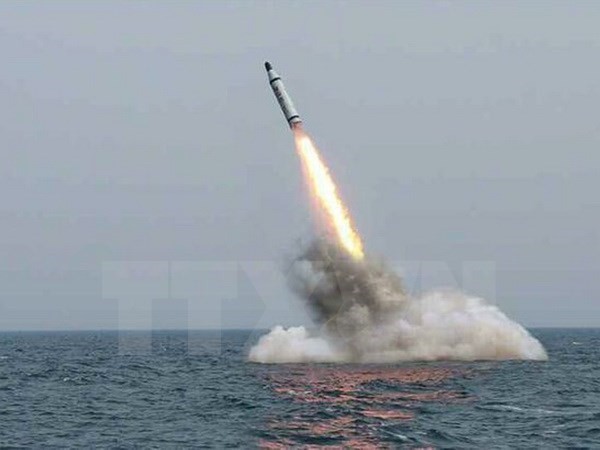(VOVworld) – North Korea recently continued testing its submarine-launched ballistic missile (SLBM), which fell inside Japan’s Air Defense Identification Zone over the Sea of Japan. This was Pyongyang’s third missile launch since early this year, in response to what Pyongyang considers provocative acts conducted by the US and its allies in the region. The latest missile test, which was viewed as a success, has caused concerns among the international community as parties involved continue their sabre-rattling.
 |
North Korea's submarine-launched ballistic missile
(Photo: EPA/VNA) |
On August 24, North Korea fired an SLBM, which flew 500km to the northeast before falling about 80km inside Japan’s Air Defense Identification Zone. The first launch, on April 23, was a failure, as the missile, which was ejected from a depth of 10m underwater, only flew 30km before exploding. In the second test, on July 9, the missile was successfully launched from the submarine, but it exploded at a height of 10km.
Experts say Pyongyang has proven that it will soon acquire launching technology and may deploy strategic ballistic missiles as early as next year rather than in two or three years as predicted.
Grave warnings and strong retaliation
North Korea’s firing of the strategic missile coincided with the Foreign Ministers’ Meeting of Japan, China, and South Korea on August 24, the first of its kind since March 2015. The meeting discussed responses to Pyongyang’s development of ballistic missiles. On August 22, North Korea strongly condemned US-South Korea joint military drill “Ulchi Freedom Guardian,” which mobilized some 75,000 troops.
Pyongyang’s response was considered the strongest so far, given the US’s deployment of a fleet of strategic bombers B-1B Lancer and 300 air force personnel in charge of bomber maintenance. The US also installed Terminal High Altitude Area Defense (THAAD) in Seongju County of South Korea. The North issued strong warnings, saying it was ready to launch pre-emptive nuclear attacks on the armed forces of the South and the US. North Korea’s leader Kim Jong Un called on young people to be a “death-defying corps” in defending the nation. Seoul was also hectic in making plans for retaliation. On August 29, South Korean President Park Geun Hye ordered the army to be placed on the highest level of alert. She convened a cabinet meeting to map out effective measures to deal with North Korea’s increasing nuclear and missile capability. South Korean MPs issued a statement calling on the government to build nuclear-powered submarines.
Korean Peninsula enters a perilous new period
Experts voiced concerns over new developments on the Korean Peninsula, which are attributed to more aggressive retaliatory policies on the part of the US and its allies and North Korea’s disregard for the UN Security Council’s sanctions. They predicted that Pyongyang is capable of fighting back any invasion of hostile forces. The successful August 24 missile test has enabled the North to equip its submarines with missiles and develop more advanced submarines. This also proved that Pyongyang is resuming its production of weapons-grade plutonium at its Yongbyon Nuclear Reactor, which was halted in accordance with agreements reached at six party nuclear talks several years ago.
Pyongyang’s nuclear and missile capability is real and have been ineffective. Sanctions and other strong measures taken by the international community have not improved the situation on the Korean Peninsula. Peaceful measures to resolve the issue and the restraint of parties involved are needed to ease tensions and prevent the situation from deteriorating.